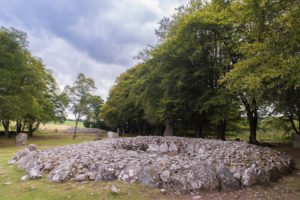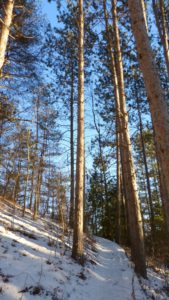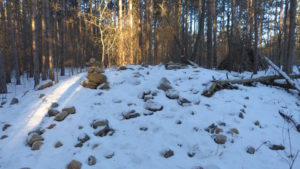*An excerpt from my new upcoming book, Thank Our Lucky Stones (Mary Loretta McGillis)
The Clava Cairns in the Highlands of Scotland
A cairn is a human-made pile or stack of stones. There is a centuries old Scottish tradition of carrying a stone from the bottom of the valley and placing on top of an existing cairn, or adding a stone each time you visit a burial place. The word cairn comes from the Scottish Gaelic word càrn (heap of stones). A cairn site is said to have different purposes: to mark a grave, to mark a successful reaching of a summit, to mark a path or as a sea marker to help mariners.
An ancient Scottish blessing, “Cuiridh mi clach air do charn” means “I will put a stone on your cairn”.
 Clava Cairns, Scotland
Clava Cairns, Scotland
The Clava Cairns in the Scottish Highlands are about 4,000 years old and were built to house the dead along the east side of the River Nairn, not far from Culloden Battlefield. The cemetery has remained a sacred place in the landscape for millennia.
A Cairn at Trent University

The first sign you see welcomes you to the Lady Eaton Drumlin Nature Area.
What is a Drumlin?
What is a drumlin? The word drumlin is derived from the gaelic word druim, ‘hill’, as they were first named in Ireland in the 1800s: Drumlins are elongated, teardrop-shaped hills of rock, sand, and gravel yet scientific reports say an explanation for their formation continues to mystify investigators.
Celtic legends associate the hills as fairy mounds and the home of the Little People or Sidhe – a gaelic word pronounced SHEE – the fairy people of Irish folklore, said to live beneath the hills and also known as the realm of the ancient gods and goddesses, the Tuatha Dé Danann (the people of the Goddess Danu).

Take the Blue Trail … up the drumlin …

Cairn at Trent University
 Trent University Cairn, Canada
Trent University Cairn, Canada
Going back down the drumlin, see Julian Blackburn Hall through the trees and on the road into the campus. Peaceful.
 Peace in Peterborough, Canada
Peace in Peterborough, Canada
